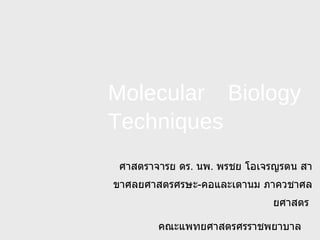
Molecular Biology
- 1. Molecular Biology Techniques ศาสตราจารย ดร . นพ . พรชย โอเจรญรตน สาขาศลยศาสตรศรษะ - คอและเตานม ภาควชาศลยศาสตร คณะแพทยศาสตรศรราชพยาบาล
- 2. Surgical leaders, now and in the near future must be good biologists as well as good surgeons. Murray Brennan 2002 The care of the patient is an exercise in human biology. Theodor Billroth 1870
- 3. The cell „ The cell is the fundamental working unit of every living organism. „ Humans: trillions of cells (metazoa); other organisms like yeast: one cell (protozoa). „ Cells are of many different types (e.g. blood, skin, nerve cells), but all can be traced back to a single cell, the fertilized egg.
- 4. The human genome „ The genome , or blueprint for all cellular structures and activities in our body, is encoded in DNA molecules. „ Each cell contains a complete copy of the organism's genome . „ Contains DNA sequences of 3 billion base pairs
- 5. The human genome „ The human genome is distributed along 23 pairs of chromosomes 22 autosomal pairs; the sex chromosome pair: XX for females and XY for males. „ In each pair, one chromosome is paternally inherited, the other maternally inherited (cf. meiosis).
- 6. The human genome „ Chromosomes are made of compressed and entwined DNA . „ A (protein-coding) gene is a segment of chromosomal DNA that directs the synthesis of a protein . „ An estimated 25,000 to 30,000 genes and is 99.9% identical in all people
- 8. DNA „ A deoxyribonucleic acid or DNA molecule is a double - stranded polymer composed of four basic molecular units called nucleotides . „ Each nucleotide comprises a phosphate group, a deoxyribose sugar, and one of four nitrogen bases : adenine ( A ) , guanine ( G ) , cytosine ( C ) , and thymine ( T ) . „ The two chains are held together by hydrogen bonds between nitrogen bases. „ Base-pairing occurs according to the following rule: G pairs with C , and A pairs with T .
- 9. DNA
- 10. Differential expression „ Each cell contains a complete copy of the organism's genome. „ Cells are of many different types and states E.g. blood, nerve, and skin cells, dividing cells, cancerous cells, etc. What makes the cells different ? „ Differential gene expression , i.e., when , where , and in what quantity each gene is expressed. „ On average, 40% of our genes are expressed at any given time.
- 11. Different Genes – Different Functions Bone Cell Pancreas Cell Brain Cell
- 12. Gene Structure „ The genes are made up of DNA sequences. - Promoters - Exons - Introns
- 13. Exons and introns „ Genes comprise only about 2% of the human genome; the rest consists of non-coding regions, whose functions may include providing chromosomal structural integrity and regulating when, where, and in what quantity proteins are made (regulatory regions). „ The terms exon and intron refer to coding (translated into a protein) and non-coding DNA, respectively.
- 15. Alternative splicing „ There are more than 1,000,000 different human antibodies. How is this possible with only ~30,000 genes ? Alternative splicing refers to the different ways of combining a gene’s exons. This can produce different forms of a protein for the same gene. „ Alternative pre-mRNA splicing is an important mechanism for regulating gene expression in higher eukaryotes. E.g. in humans, it is estimated that approximately 30% genes are subject to alternative splicing.
- 16. Central Dogma
- 17. The genetic code Mapping between codons and amino acids is many-to-one: 64 codons but only 20 a.a.. Third base in codon is often redundant, e.g., stop codons.
- 18. The Control of Gene Expression
- 19. Molecular Biology Techniques „ DNA cloning „ Nucleic acid and protein analysis - nucleic acid hybridization ( southern blot, northern blot, PCR ) - immunoblot & immunoprecipitation - DNA microarray „ Cell culture „ Genetic manipulation - transgenic mice, gene knockout - RNA interference
- 20. DNA Cloning
- 21. Nucleic Acid Probe Technology target probe ‘ Hybridization’: Formation of a double helix from two single-stranded nucleic acid segments through the complementary base pairing. „ Southern hybridization analysis can determine whether a particular gene is present in the sample of DNA, and provides estimation of the number of gene copies.
- 22. Southern Blot
- 23. Northern Blot
- 26. RT - PCR ( reverse transcription - polymerase chain reaction ) „ RNA is reverse transcribed to DNA. „ PCR procedures can be used amplify DNA at exponential rate. „ Gel quantification for the amplified product . ---- an semi - quantitative method .
- 27. Real - time RT - PCR The PCR amplification can be monitored by fluorescence in “real time”. „ The fluorescence values recorded in each cycle represent the amount of amplified product. ---- an quantitative method. The current most advanced and accurate analysis for mRNA abundance. Usually used to validate microarray result.
- 28. Gene Expression Analysis Method Typical / Throughput • Northern blot 1 gene • Subtractive cloning • Differential display • 2 D protein gel • ICAT / Tandem Mass Spec • EST / SAGE • Gridded filters • High density arrays 20,000-40,000 genes
- 29. What is a DNA Microarray? DNA microarrays rely on the hybridization properties of nucleic acids to monitor DNA or RNA abundance on a genomic scale in different types of cells. Hybridized slide Two dyes Image analyzed Tens of thousands of spots
- 30. Hybridization RNA fragments with fluorescent tags from sample to be tested RNA fragments hybridizes with DNA on GeneChip
- 32. Immunoblot ( Western Blot )
- 33. Cell Culture and Transfection
- 35. RNA Interference
- 36. Surgery 20 th Century 21st Century Physiology anatomy Anesthesia Asepsis antibiotics Robotics Fiberoptics Imaging Computers Maximally invasive Minimally invasive Molecular biology genetics
